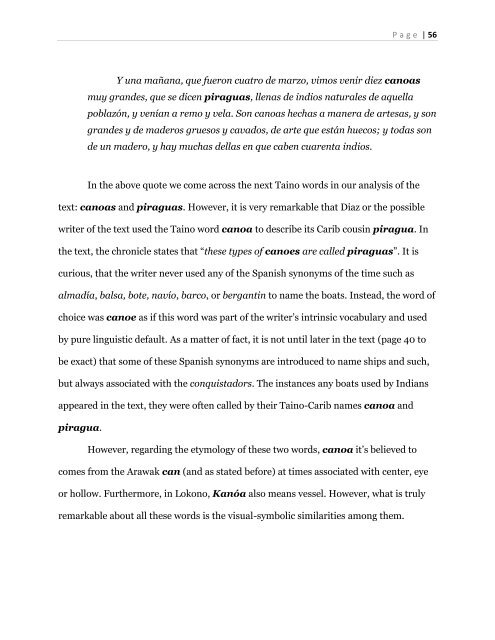Language of the Voiceless: Traces of Taino Language, Food, and Culture in the Americas From 1492 to the Present
by Leonardo Nin
by Leonardo Nin
Create successful ePaper yourself
Turn your PDF publications into a flip-book with our unique Google optimized e-Paper software.
P a g e | 56<br />
Y una mañana, que fueron cuatro de marzo, vimos venir diez canoas<br />
muy gr<strong>and</strong>es, que se dicen piraguas, llenas de <strong>in</strong>dios naturales de aquella<br />
poblazón, y venían a remo y vela. Son canoas hechas a manera de artesas, y son<br />
gr<strong>and</strong>es y de maderos gruesos y cavados, de arte que están huecos; y <strong>to</strong>das son<br />
de un madero, y hay muchas dellas en que caben cuarenta <strong>in</strong>dios.<br />
In <strong>the</strong> above quote we come across <strong>the</strong> next <strong>Ta<strong>in</strong>o</strong> words <strong>in</strong> our analysis <strong>of</strong> <strong>the</strong><br />
text: canoas <strong>and</strong> piraguas. However, it is very remarkable that Diaz or <strong>the</strong> possible<br />
writer <strong>of</strong> <strong>the</strong> text used <strong>the</strong> <strong>Ta<strong>in</strong>o</strong> word canoa <strong>to</strong> describe its Carib cous<strong>in</strong> piragua. In<br />
<strong>the</strong> text, <strong>the</strong> chronicle states that “<strong>the</strong>se types <strong>of</strong> canoes are called piraguas”. It is<br />
curious, that <strong>the</strong> writer never used any <strong>of</strong> <strong>the</strong> Spanish synonyms <strong>of</strong> <strong>the</strong> time such as<br />
almadía, balsa, bote, navío, barco, or bergant<strong>in</strong> <strong>to</strong> name <strong>the</strong> boats. Instead, <strong>the</strong> word <strong>of</strong><br />
choice was canoe as if this word was part <strong>of</strong> <strong>the</strong> writer’s <strong>in</strong>tr<strong>in</strong>sic vocabulary <strong>and</strong> used<br />
by pure l<strong>in</strong>guistic default. As a matter <strong>of</strong> fact, it is not until later <strong>in</strong> <strong>the</strong> text (page 40 <strong>to</strong><br />
be exact) that some <strong>of</strong> <strong>the</strong>se Spanish synonyms are <strong>in</strong>troduced <strong>to</strong> name ships <strong>and</strong> such,<br />
but always associated with <strong>the</strong> conquistadors. The <strong>in</strong>stances any boats used by Indians<br />
appeared <strong>in</strong> <strong>the</strong> text, <strong>the</strong>y were <strong>of</strong>ten called by <strong>the</strong>ir <strong>Ta<strong>in</strong>o</strong>-Carib names canoa <strong>and</strong><br />
piragua.<br />
However, regard<strong>in</strong>g <strong>the</strong> etymology <strong>of</strong> <strong>the</strong>se two words, canoa it’s believed <strong>to</strong><br />
comes from <strong>the</strong> Arawak can (<strong>and</strong> as stated before) at times associated with center, eye<br />
or hollow. Fur<strong>the</strong>rmore, <strong>in</strong> Lokono, Kanóa also means vessel. However, what is truly<br />
remarkable about all <strong>the</strong>se words is <strong>the</strong> visual-symbolic similarities among <strong>the</strong>m.


















